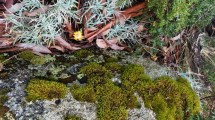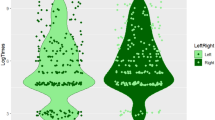Abstract
Honeybees Apis mellifera were trained to distinguish between the presence and the absence of a rewarded coloured spot, presented on a vertical, achromatic plane in a Y-maze. They were subsequently tested with different subtended visual angles of that spot, generated by different disk diameters and different distances from the decision point in the device. Bees were trained easily to detect bee-chromatic colours, but not an achromatic one. Chromatic contrast was not the only parameter allowing learning and, therefore, detection: α min, the subtended visual angle at which the bees detect a given stimulus with a probability P 0 = 0.6, was 5° for stimuli presenting both chromatic contrast and contrast for the green photoreceptors [i.e. excitation difference in the green photoreceptors, between target and background (green contrast)], and 15° for stimuli presenting chromatic but no green contrast. Our results suggest that green contrast can be utilized for target detection if target recognition has been established by means of the colour vision system. The green-contrast signal would be used as a far-distance signal for flower detection. This signal would always be detected before chromatic contrast during an approach flight and would be learned in compound with chromatic contrast, in a facilitation-like process.
Similar content being viewed by others
References
Backhaus W (1991) Color opponent coding in the visual system of the honeybee. Vision Res 31: 1381–1397
Backhaus W (1992) Color vision in honey bees. Neurosci Biobehav Rev 16: 1–12
Backhaus W (1993) Color vision and color choice behavior of the honeybee. Apidologie 24: 309–331
Backhaus W, Menzel R (1987) Color distance derived from a receptor model of color vision in the honeybee. Biol Cybern 55: 321–331
Backhaus W, Menzel R, Kreißl S (1987) Multidimensional scaling of color similarity in bees. Biol Cybern 56: 293–304
Braitenberg V (1970) Ordnung und Orientierung der Elemente im Sehsystem der Fliege. Kybernetik 7: 235–242
Brandt R, Backhaus W, Dittrich M, Menzel R (1993) Simulation of threshold spectral sensitivity according to the color theory for the honeybee. In: Heisenberg M, Elsner N (eds) Gene-brainbehaviour. Proc 21st Göttingen Neurobiology Conference. Thieme, Stuttgart, p 374
Butler CG (1951) The importance of perfume in the discovery of food by the worker honey-bee (Apis mellifera L.). Proc R Soc Lond B 138: 403–413
Chittka L, Menzel R (1992) The evolutionary adaptation of flower colours and the insect pollinators' colour vision. J Comp Physiol A 171: 171–181
Chittka L, Beier W, Hertel H, Steinmann E, Menzel R (1992) Opponent coding is a universal strategy to evaluate the photoreceptor inputs in Hymenoptera. J Comp Physiol A 170: 545–563
Chittka L, Shmida A, Troje N, Menzel R (1994) Ultraviolet as a component of flower reflections, and the colour perception of Hymenoptera. Vision Res 34: 1489–1508
Daumer K (1956) Reizmetrische Untersuchung des Farbensehens der Bienen. Z Vergl Physiol 38: 413–478
Domjan M, Burkhard B (1986) The principles of learning and behavior. Brooks/Cole, California
Faegri K, van der Piji L (1978) The principles of pollination ecology. 3rd ed. Pergamon, Oxford
Frisch K (1919) Über den Geruchsinn der Bienen und seine blütenbiologische Bedeutung. Zool Jb Physiol 37: 2–238
Frisch Kv (1965) Tanzsprache und Orientierung der Bienen. Springer, Berlin
Götz KG (1964) Optomotorische Untersuchung des visuellen Sytems einiger Augenmutanten der Fruchtfliege Drosophila. Kybernetik 2: 77–92
Heiversen Dv (1972) Zur spektralen Unterschiedsempfindlichkeit der Honigbiene. J Comp Physiol 80: 439–472
Hollan PC (1983) “Occasion setting” in Pavlovian feature positive discriminations. In: Commons ML, Herrnstein RJ, Wagner AR (eds) Quantitative analyses of behavior: discrimination processes. Ballinger, Cambridge, vol 4, pp 183–206
Kaiser W, Liske E (1974) Die optomotorische Reaktionen von fixiert fliegenden Bienen bei Reizung mit Spektrallichtern. J Comp Physiol 89: 391–408
Kevan PG (1989) How honey bees forage for pollen at skunk cabbage, Symplocarpus foetidus (Araceae). Apidologie 20: 485–490
Kevan PG, Baker HG (1983) Insects as flower visitors and pollinators. Annu Rev Entomol 28: 407–453
Kevan PG, Eisikowitch D, Ambrose JD, Kemp JR (1990) Cryptic dioecy and insect pollination in Rosa setiyera Michx. (Rosaceae), a rare plant of Carolinian Canada. Biol J Linn Soc 40: 229–243
Kirschfeld K (1973) Optomotorische Reaktionen der Biene auf bewegte“Polarisations-Muster”. Z Naturforsch 28c: 329–338
Kugler H (1933) Blütenökologische Untersuchungen mit Hummeln VI. Planta, Arch wiss Bot 19: 781–789
Laughlin SB, Horridge GA (1971) Angular sensitivity of the retinula cells of dark-adapted worker bee. Z Vergl Physiol 74: 329–335
Lehrer M (1987) To be or not to be a colour-seeing bee. Israel J Entomol 21: 51–76
Lehrer M (1993) Parallel processing of motion, shape and colour in the visual system of the bee. In: Wiese K, Gribakin FG, Popov AV, Reinninger G (eds) Sensory systems of arthropods. Birkhäuser, Basel, pp 266–272
Lehrer M (1994) Spatial vision in the honeybee: the use of different cues in different tasks. Vision Res 34: 2363–2385
Lehrer M, Bischof S (1995) Detection of model flowers by honeybees: the role of chromatic and achromatic contrast. Naturwissenschaften 82: 145–147
Lehrer M, Srinivasan MV (1993) Object detection by honeybees: Why do they land on edges? J Comp Physiol A 173: 23–32
Lehrer M, Srinivasan MV, Zhang SW, Horridge GA (1988) Motion cues provide the bees' visual world with a third dimension. Nature 332: 356–357
Lehrer M, Srinivasan MV, Zhang SW (1990) Visual edge detection in the honeybee and its chromatic properties. Proc R Soc Lond B 238: 321–330
Menzel R (1967) Untersuchungen zum Erlernen von Spektralfarben durch die Honigbiene (Apis mellifica). Z Vergl Physiol 56: 22–62
Menzel R (1968) Das Gedächtnis der Honigbiene für Spektralfarben. I. Kurzzeitiges langzeitiges Behalten. Z Vergl Physiol 60: 82–102
Menzel R (1985) Learning in honeybees in an ecological and behavioral context. In: Hölldobler B, Lindauer M (eds) Experimental behavioral ecology. Fischer, Stuttgart, pp 55–74
Menzel R, Backhaus W (1991) Colour vision in insects. In: Gouras P (ed) Vision and visual dysfunction. The perception of colour. MacMillan, London, pp 262–288
Menzel R, Greggers U (1985) Natural phototaxis and its relationship to colour vision in honeybees. J Comp Physiol A 157: 311–321
Menzel R, Shmida A (1993) The ecology of flower colours and the natural colour vision of insect pollinators: the Israeli flora as a study case. Biol Rev 68: 81–120
Menzel R, Greggers U, Hammer M (1993) Functional organization of appetitive learning and memory in a generalist pollinator, the honey bee. In: Papaj D, Lewis AC (eds) Insect learning. Ecological and evolutionary perspectives. Chapman & Hall, New York, pp 79–125
Rescorla RA, Durlach PJ, Grau JW (1985) Context learning in Pavlovian conditioning. In: Balsam PD, Tomie A (eds) Context and learning. Erlsbaum, Hillsdale, pp 23–56
Rossel S (1993) Navigation by bees using polarized skylight. Comp Biochem Physiol 104A: 695–708
Rossel S, Wehner R (1986) Polarization vision in bees. Nature 323: 128–131
Seidl R (1980) Die Sehfelder und Ommatidien-Divergenzwinkel der drei Kasten der Honigbiene (Apis mellifica). Verh Dtsch Zool Ges 1980: 367
Snyder A W (1979) Physics of vision in compound eyes. In: Autrum HJ (ed) Vision in invertebrates (Handbook of Sensory Physiology, vol VII/6A). Springer, Berlin Heidelberg New York, pp225–313
Srinivasan MV, Lehrer M (1988) Spatial acuity of honeybee vision and its spectral properties. J Comp Physiol A 162: 159–172
Stavenga DG (1979) Pseudopupils of compound eyes. In: Autrum HJ (ed) Vision in invertebrates (Handbook of Sensory Physiology, vol VII/6A). Springer, Berlin Heidelberg New York, pp357–439
Tunstall J, Horridge GA (1967) Electrophysiological investigation of the optics of the locust retina. Z Vergl Physiol 55: 167–182
Vallet AM, Coles JA (1993) The perception of small objects by the drone honeybee. J Comp Physiol A 172: 183–188
Wehner R (1972) Dorsoventral asymmetry in the visual field of the bee Apis mellifica. J Comp Physiol 77: 256–277
Wehner R (1973) The generalization of directional visual stimuli in the honey bee, Apis mellifera. J Insect Physiol 17: 1579–1591
Weizsäcker EV (1970) Dressurversuche zum Formensehen der Bienen, insbesonders unter wechselnden Helligkeitsbedingungen. Z Vergl Physiol 69: 296–310
Zar JH (1985) Biostatistical analysis. Prentice Hall, New Jersey
Author information
Authors and Affiliations
Rights and permissions
About this article
Cite this article
Giurfa, M., Vorobyev, M., Kevan, P. et al. Detection of coloured stimuli by honeybees: minimum visual angles and receptor specific contrasts. J Comp Physiol A 178, 699–709 (1996). https://doi.org/10.1007/BF00227381
Accepted:
Issue Date:
DOI: https://doi.org/10.1007/BF00227381




